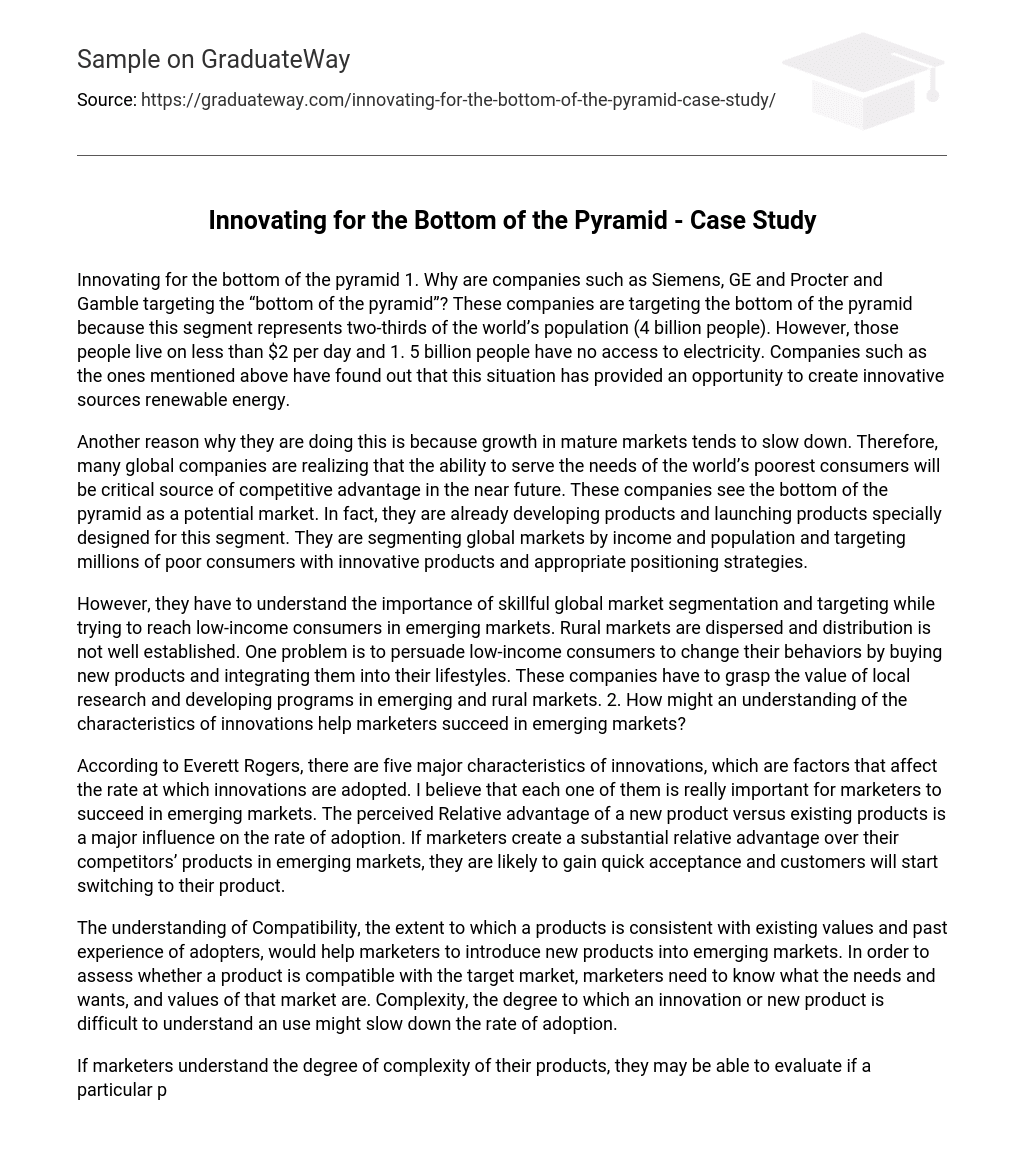Innovating for the bottom of the pyramid 1. Why are companies such as Siemens, GE and Procter and Gamble targeting the “bottom of the pyramid”? These companies are targeting the bottom of the pyramid because this segment represents two-thirds of the world’s population (4 billion people). However, those people live on less than $2 per day and 1. 5 billion people have no access to electricity. Companies such as the ones mentioned above have found out that this situation has provided an opportunity to create innovative sources renewable energy.
Another reason why they are doing this is because growth in mature markets tends to slow down. Therefore, many global companies are realizing that the ability to serve the needs of the world’s poorest consumers will be critical source of competitive advantage in the near future. These companies see the bottom of the pyramid as a potential market. In fact, they are already developing products and launching products specially designed for this segment. They are segmenting global markets by income and population and targeting millions of poor consumers with innovative products and appropriate positioning strategies.
However, they have to understand the importance of skillful global market segmentation and targeting while trying to reach low-income consumers in emerging markets. Rural markets are dispersed and distribution is not well established. One problem is to persuade low-income consumers to change their behaviors by buying new products and integrating them into their lifestyles. These companies have to grasp the value of local research and developing programs in emerging and rural markets. 2. How might an understanding of the characteristics of innovations help marketers succeed in emerging markets?
According to Everett Rogers, there are five major characteristics of innovations, which are factors that affect the rate at which innovations are adopted. I believe that each one of them is really important for marketers to succeed in emerging markets. The perceived Relative advantage of a new product versus existing products is a major influence on the rate of adoption. If marketers create a substantial relative advantage over their competitors’ products in emerging markets, they are likely to gain quick acceptance and customers will start switching to their product.
The understanding of Compatibility, the extent to which a products is consistent with existing values and past experience of adopters, would help marketers to introduce new products into emerging markets. In order to assess whether a product is compatible with the target market, marketers need to know what the needs and wants, and values of that market are. Complexity, the degree to which an innovation or new product is difficult to understand an use might slow down the rate of adoption.
If marketers understand the degree of complexity of their products, they may be able to evaluate if a particular product is suitable for the target market or not. Divisibility, the ability of a product to be tried and used on a limited basis without great expense, might help marketers to introduce a new product into an emerging market if that product can be used on a small scale for trial purposes because it tends to facilitate adoption. Promotions that involve small samples of products often produce satisfactory trial results. Since risk is one of the major considerations in the adoption process, divisibility is an important factor.
Communicability, the degree to which benefits of an innovation or the value of a product may be communicated to a potential market, is also useful while introducing new products into emerging markets. If marketers communicate properly all features and characteristics of the product they are launching, that product introduction might have a positive effect and can end up being a successful product in emerging markets. 3. What types of marketing communications may be necessary to launch an innovative product such as Procter and Gamble’s PUR in emerging markets?
What changes in consumer attitudes and behavior are required for successfully launching a product such as PUR? I believe that the types of marketing communications or promotion that may be necessary that scenario would be a mix of personal selling and sampling. Many rural areas in emerging markets lack electricity making mass media advertising (tv, radio, internet) not suitable for these markets. A better strategy would be personal selling in which sales representatives go door to door to introduce the product to potential consumers and they can also explain how it works and the benefits it offers.
Additionally, the can give some samples to consumers so they can try the product out by their own and make a decision. Consumers should be open to try new and different products. They have to be willing to use a new product that is going to benefit and improve their lives. In order to do that, marketers must be very careful on how they advertise their products. They should highlight the benefits offered to the user and make sure that the message is clear enough and has a low degree of complexity so the information can be communicated smoothly. References Warren J. Keegan, Mark. C. Green (2012) Global Marketing.





